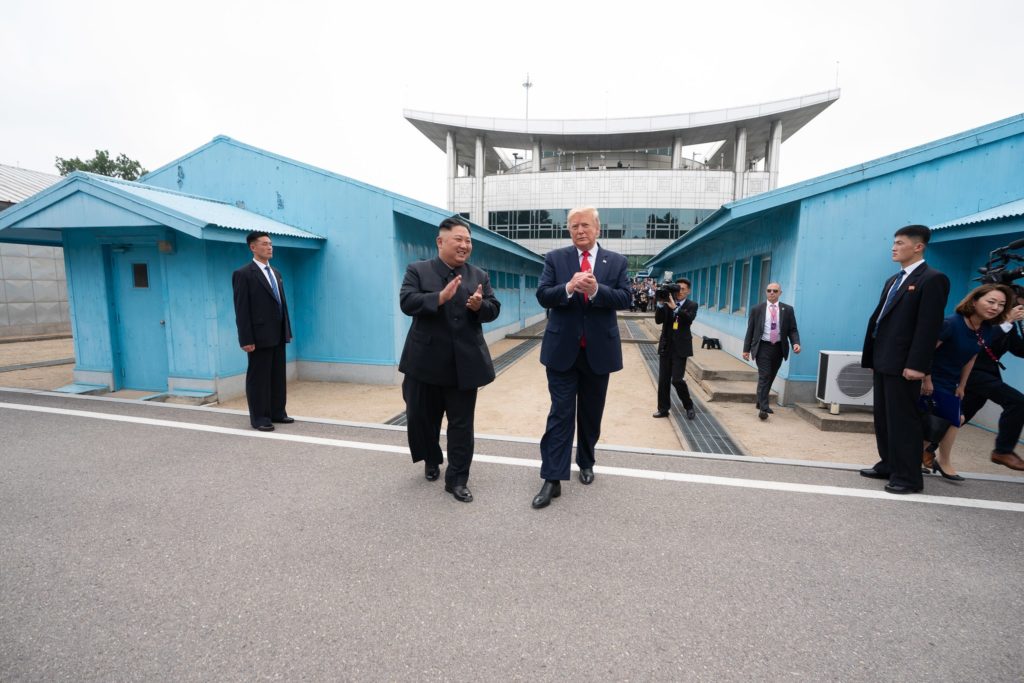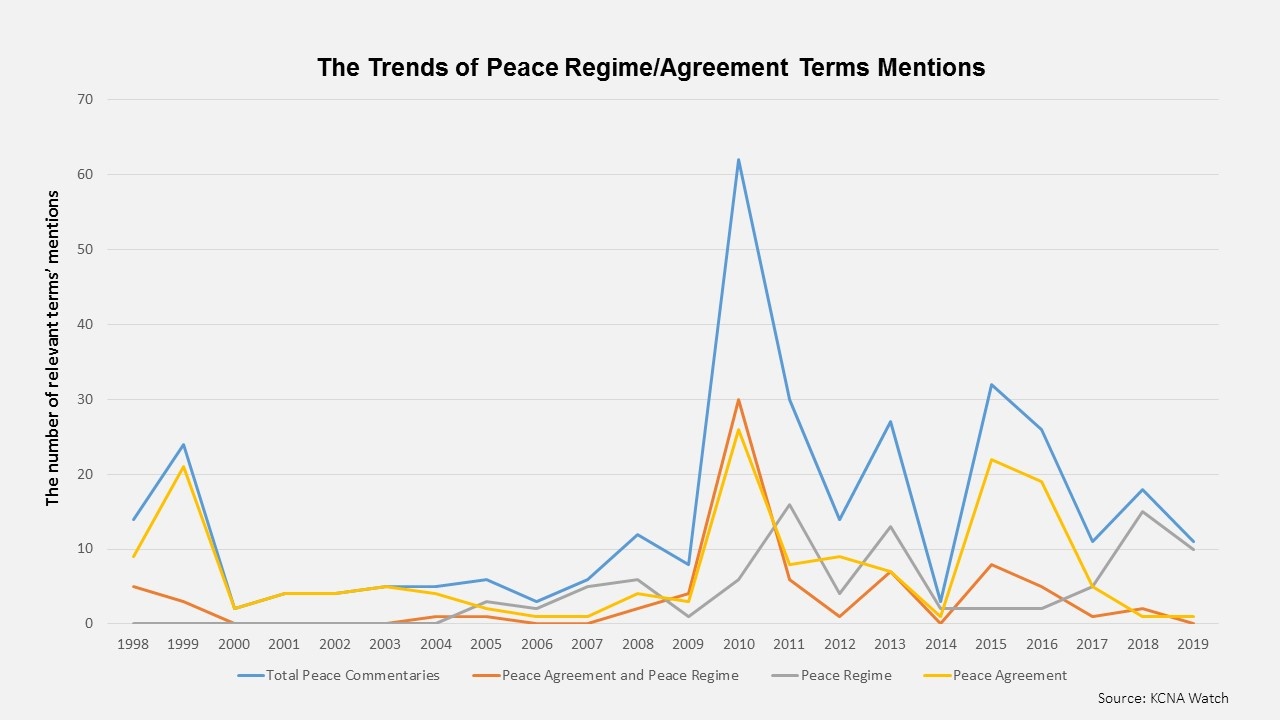The Peninsula
North Korean Peace Proposals: A Long-run View
Published July 1, 2020
Category: North Korea

By Stephan Haggard and Liuya Zhang
Over the last thirty years, North Korea has periodically made reference to the importance of reaching a “peace agreement” or negotiating a “peace regime.” Most recently, The Panmunjom declaration suggested the parties might exchange denuclearization of the Korean Peninsula for a peace agreement (평화협정). The historic Trump-Kim summit made reference to “building a lasting and stable peace regime (평화체제) on the Korean Peninsula”; indeed the reference to a peace regime appeared in the summit document even before mention of denuclearization.
Although we have some sense of North Korean grievances vis-à-vis the United States—and vice versa—we do not have a very precise sense of what negotiations over a peace agreement or peace regime would look like, or even whether there is genuine North Korean interest. With few exceptions these terms have only rarely been attached to a very clear picture of what North Korea would like to see.
However, we can get some sense of North Korean intent by taking a broader look at the use of these terms over time. To provide this longer-run view, we scraped 1305 articles published between January 1st, 1998 to December 31, 2019 in the KCNA.co.jp (Korean) Archive inside the KCNA Watch database,[i] restricting the search to the following Korean terms: 평화(보장)체제 (peace regime) and 평화협정 (peace agreement).[ii] We kept only articles that represented what we considered authoritative opinions, which we divided into “first-tier” commentary—from the supreme leaders themselves or institutions such as the National Defense Commission, Foreign Ministry or Supreme People’s Assembly—and “second-tier” commentaries from major state media, including Rodong Sinmun, the Korean Central News Agency (KCNA) and others. This selection criteria left us with 327 articles, 120 first-tier and 207 second-tier.
An analysis of these statements, and their intended audience, suggests a pattern that is well-known to most Korea watchers. The term “peace agreement” is typically used in the context of negotiating the normalization of relations with the United States, implying a bilateral agreement that would address policy issues immediately under American control: the withdrawal of U.S. forces, suspension of exercises, the lifting of sanctions. A peace regime, by contrast, is a multilateral agreement among the four parties—South and North Korea, China and the United States—that would replace the armistice.
Figure 1 provides an overview of mentions of the two terms over time, and suggests several interesting patterns. Although there was some use of the term “peace agreement” during the Four Party Talks (1998-99), there was surprisingly little usage of these concepts during the period leading into the second nuclear crisis nor the heyday of the Six Party Talks. We did see a brief flurry of interest in reaching a non-aggression treaty (불가침조약) in 2003-4, at the outset of the Six Party Talks, when North Korea appeared preoccupied with getting security assurances that would carry the imprimatur of Congressional approval.

From 2005 through 2008 we see some increased usage of the terms as the Six Party Talks reached its short-lived apex in 2007-8. But during this period, North Korea seemed more focused on negotiating the quid-pro-quos around a nuclear agreement, including the lifting of sanctions, provision of heavy fuel oil and pursuit of a light-water reactor; thinking about a wider “mechanism” or regime was pushed off to later phases of the talks in the two roadmap agreements of 2007.
What is striking is that usage of the peace agreement and peace regime terms increases dramatically in 2010, and then spikes again in 2013, 2015 and 2018. Several hypotheses suggest themselves, and they are not altogether mutually exclusive. One hypothesis is that North Korea turned toward the peace agreement and peace regime proposals precisely as an alternative to the Six Party Talks, which were focused on denuclearization. Indeed, in important statements in 2009 and 2010, North Korea began to float the idea that reaching a peace agreement with the United States was a prerequisite for resuming the Six Party Talks.[iii]
A second hypothesis is that the new reference to a peace regime was designed to stabilize the external environment as the succession process went into high gear following Kim Jong-il’s likely stroke in August 2008.
We focus, however, on a third hypothesis. That at least until 2018, the floating of peace agreement and peace regime ideas is related to a stepped up cycle of provocations. These begin with the nuclear and missile tests of 2009, and go through the sinking of the Cheonan and Yeongpyong-do shelling in 2010, and the acceleration of nuclear and missile testing under Kim Jong-un.
Under this hypothesis, North Korea might float these ideas for two reasons. “Peace offensives” were designed to assign—or shift—blame for ongoing tensions to the United States and are issued prior to an escalation of tensions. “Pacifying campaigns” by contrast, seek to de-escalate and are undertaken after tensions rise. Under this more cynical view, peace agreement and peace regime ideas are not to be taken seriously; they do not necessarily reflect an interest in actually negotiating such agreements but are essentially strategic.
It is arguably hopeful that there was a spike in mentions of a peace regime in 2018 that was sustained into 2019. Prior to the Hanoi summit, hopes were raised of a grand bargain that might achieve the trifecta of a denuclearization agreement, a normalization of relations with the United States, and a wider peace settlement that would replace the armistice. Yet the Hanoi summit was a bitter disappointment for the Kim Jong-un regime, and it is noteworthy that since 2016 interest in a peace agreement with the United States has clearly waned. In the absence of a meaningful path back to talks with the United States, with North-South relations on ice, and with North Korea comfortable with its nuclear deterrent, even aspirational peace regime proposals may play a declining signaling role in the diplomacy around the peninsula.
Stephan Haggard is a Non-Resident Fellow at the Korea Economic Institute and the Lawrence and Sallye Krause Professor of Korea-Pacific Studies, Director of the Korea-Pacific Program and distinguished professor of political science at the School of Global Policy and Strategy University of California San Diego. Liuya Zhang is a master student at the School of Global Policy and Strategy, University of California, San Diego. She received her Bachelor Degree of Arts from Fudan University and Master’s degree of International Studies from Seoul National University. The views expressed here are the authors’ alone.
Photo from White House photostream on flickr Creative Commons.
[i] Data source:
https://kcnawatch.org/advanced-search/?all_word=&any_word=평화협정%2C+평화조약%2C+평화보장체제%2C+평화체제&exclude=&sources%5B%5D=190036&sources%5B%5D=&sources%5B%5D=&restrict=both&from_date=01-01-1990&to_date=31-12-2019&adv_search=
[ii] . We also searched for the term 평화조약 (peace treaty), but it’s usage was exceedingly rare and was used primarily in reference to peace treaties reached elsewhere beyond the Korean peninsula.
[iii] 로동신문 《평화보장체계수립이 급선무이다》, 23/11/2009, Source: KCNA.co.jp (Korean)
조선외무성 성명 평화협정회담을 제의Date: 11/01/2010 | Source: KCNA.co.jp (Kr)
